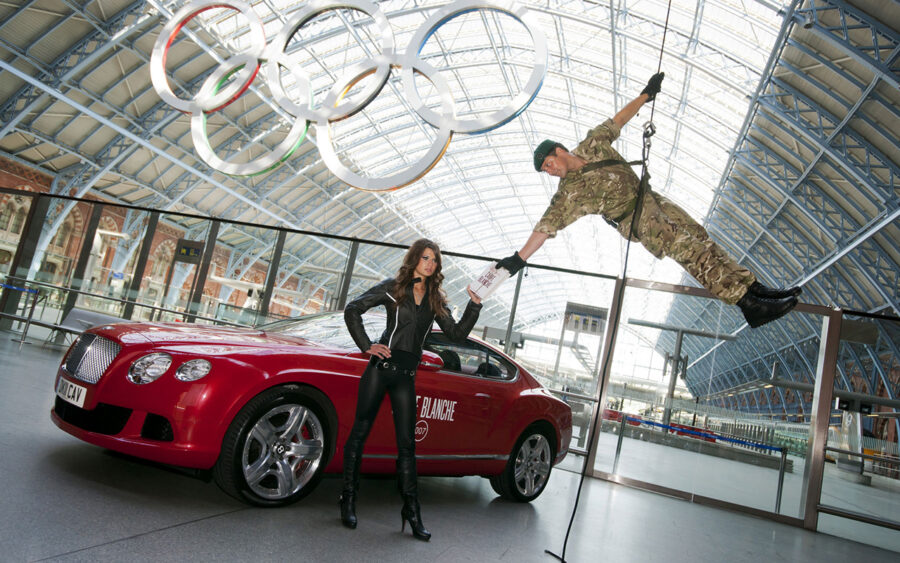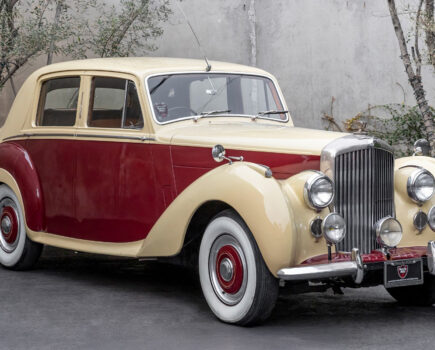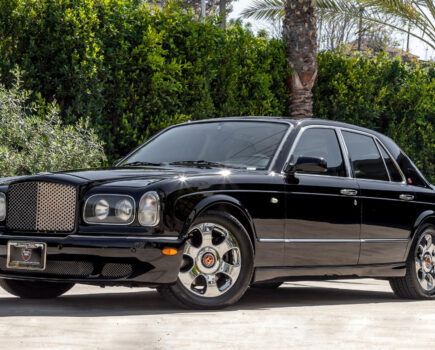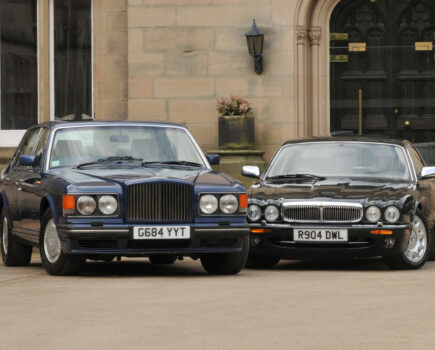The cinematic incarnation of James Bond is synonymous with Aston Martin, but Bentley is his preference in print. Here’s how Bond came to drive a B-badged car
Words: Richard Gunn
Aston Martin has become the car brand most associated with fictional superspy James Bond ever since an immaculately Anthony Sinclair-suited Sean Connery took a silver DB5 out for a quick spin to Switzerland in 1964’s Goldfinger. Since then, only Roger Moore’s 007 hasn’t slipped behind the wheel of an Aston while on Her Majesty’s secret service. He had to console himself instead with some Lotus Esprits and a Citroen 2CV. However, while the cinematic 007 may be firmly wedded to his Astons, the literary Bond – as written by author Ian Fleming – only had eyes for Bentley.
It’s an affiliation that’s less well-known than the famous Aston association, yet the character owned three different models in the Fleming works alone. Continuation novels have subsequently reintroduced Bond to Bentleys, and Aston Martin hasn’t had it all its own way in the films either, with the odd Bentley also sneaking on-screen. Here we’ll be taking a look at precisely what Winged B machines 007 has driven – and occasionally destroyed.
“The scent and smoke and sweat of a casino are nauseating at three in the morning.” So began 1953’s Casino Royale novel, introducing James Bond to the world. Journalist Ian Fleming drew on his own wartime Naval Intelligence experience to create his superspy, and indulged him with the same rich tastes, personality and love of the high life as himself. Naturally, that included an interest in fast, expensive cars, and for a patriotic British spy of that era, few marques quite fitted the bill like Bentley.
Bond, it seems, was something of a classic enthusiast. His personal car in Casino Royale was a pre-war 4½ Litre Convertible Coupé boasting an Amherst Villiers supercharger and battleship grey paintwork. Charles Amherst Villiers was a gifted engineer who created the original ‘Blower’ Bentley for Henry ‘Tim’ Birkin in 1929. The Roots-type supercharger he bolted onto the front of Birkin’s 4½ Litre boosted power from 110bhp to 175bhp (and considerably more for subsequent racing versions), much to the chagrin of W.O. Bentley, who felt that doing so to a Bentley was to “pervert its design and corrupt its performance”. The arrangement of having the supercharger slung ahead of the radiator grille rather happily gave these cars a very distinctive look.

James Bond’s first Bentley was a 4½ Litre ‘Blower’, which ended up being crashed in both Casino Royale and Moonraker
Fleming commented in an interview that he picked a ‘Blower’ for Bond because he wanted him to “use dashing, interesting things”. But a further factor, no doubt, was that Fleming and Amherst Villiers also knew each other well, having first met in 1927. Amherst Villiers would even paint Fleming’s portrait, proving that his talents weren’t just of the mechanical kind. However, the author might have benefited from questioning his technical friend on a few details, as he initially referred to the car as a 1933 model; rather inconvenient, as the 4½ Litre was only in production between 1927 and ’31. By 1955, Fleming seemed to have realised his error and corrected the date to 1930 in Moonraker.
Bond regarded his 120mph Bentley as “his only personal hobby” and had laid it up while serving during the Second World War after buying it almost new. This throws up a further anomaly, suggesting he acquired it as a young teenager. There was an attempt to clear up this mystery in the 2007 Young Bond book Double or Die by Charlie Higson, in which it was stated that the youthful James had indeed bought the car aged thirteen with a cut of some casino winnings after helping out an American beer baron.
Full credit to Higson (best-known from TV’s The Fast Show) for trying to dig his literary predecessor out of a hole, but let’s be honest – the real reason that James Bond seemingly bought a Bentley as a schoolboy is because Fleming made an error in his sums. In the first Young Bond book, 2005’s Silverfin, Higson also sought to clarify where the love for Bentleys came from, explaining how the junior James’ guardian, Aunt Charmian, also had a 4½ Litre. Her charge decided that he wanted one when he grew up.
The Bentley was crashed towards the end of Casino Royale (in the scene where Bond is pursuing the kidnapped Vesper Lynd, performed by a barrel-rolling Aston Martin DBS V12 in the 2006 movie) and only gets mentioned in passing in 1954’s Live and Let Die. It returned in Moonraker, but only briefly. While pursuing Hugo Drax’s Mercedes-Benz 300S – a car Bond begrudgingly admires, although “typical of Drax to buy a Mercedes” was his opinion of its closet Nazi owner – it was destroyed on the A20 in Kent and ends up scrapped by a Maidstone garage. A recuperating Bond replaced it with a two-year-old Bentley MkVI with open touring bodywork, in battleship grey again, with a dark blue leather interior. Well, when you’ve just saved London from being destroyed by an atomic missile, you deserve a little treat.
Strangely, aside from a throwaway sentence in 1957’s From Russia with Love, this car was never mentioned again, possibly because 007 enjoyed his first flirtation with Aston Martin a few years later. Goldfinger was written in 1959 and, in it, Bond is assigned an Aston Martin ‘DB III’ by MI6 to shadow Auric Goldfinger’s gold-smuggling Rolls-Royce Silver Ghost. Again, Fleming got his motoring facts slightly muddled; it’s likely he meant a DB MkIII unless he genuinely wanted Bond on the streets in a pure-bred endurance racing machine, as that’s what a DB3 actually was. The Aston had several gadgets – albeit nothing like the amount of the movie DB5 – but the colour was a link with its driver’s personal Bentleys, being that favourite battleship grey again.
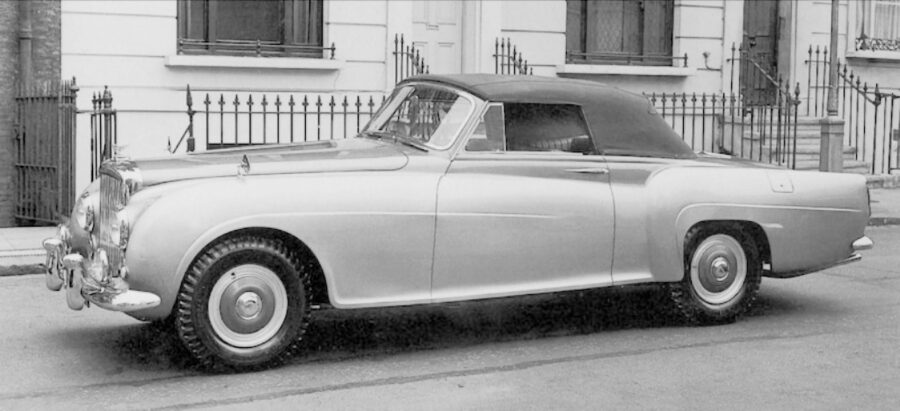
his 1954 R-Type Continental, with coachwork by Henri Chapron, provided the inspiration for 007’s The Locomotive
Bentley number three materialised in Thunderball (1961) and was a bit special. The Locomotive, as Bond christened the car, was an R-Type Continental. Fleming’s reference to it as a MkII presumably denoted a 1954-55 example fitted with the enlarged 4887cc engine. “The most selfish car in England” was bought cheap for £1500 after “some rich idiot had married (it) to a telegraph pole on the Great West Road”, and had to be returned to Rolls-Royce for its bent chassis to be straightened out. But Bond didn’t finish there.
Despite the R-Type Continental being possibly the most beautiful Bentley ever produced, its new owner then splashed out a further £3000 – half his entire savings – to have the “old cramped sports saloon” body replaced by Mulliner with an angular two-seater convertible creation sporting a “knife-edged, rather ugly boot”, a power-operated hood and an octagonal silver bolt in place of the usual Winged B mascot. The interior was finished in black Morocco leather while the paint, inevitably, was battleship grey, albeit matt rather than gloss. It was a shade rather poetically described as “elephant’s breath grey”.
Granted, with a new R-Type Continental costing £7608 at launch, Bond had secured himself a bit of a bargain by spending just £4500; but that was still a hell of a lot of money in 1961, especially on civil servant wages, when the average car was £805 and the average house £2612. Still, “she went like a bird and a bomb, and Bond loved her more than all the women at present in his life rolled, if that were feasible, together”. Coming from a man like James Bond, that was some accolade!
Fleming put in quite some research for 007’s third Bentley. During 1957, he wrote to Rolls-Royce’s chairman, Whitney Straight, to ask for information about what form a customised Bentley might take, saying that he envisaged it as a cross between a Continental and a Ford Thunderbird. For all his Englishness, Fleming was a big fan of all things American, and owned two Thunderbirds. In response he was referred to Mulliner, which knew of such a car – chassis number BC63LC.
This started life as a Mulliner-bodied fastback in May 1954. Two years later, however, it was rolled, while the owner – a Mr Silva – was racing his nephew in a Porsche. Mulliner was approached to rebuild it but the cost of its individualistic design was considered too high, and so Silva commissioned Henri Chapron of Paris instead. The French coachbuilder returned the crashed Bentley to life with a one-off steel body between May 1956 and July ’58, at a cost of 2.3 million francs. However, it seems that Chapron’s execution wasn’t as elegant and accurate as Mulliner’s blueprints specified, and what emerged divided opinion.
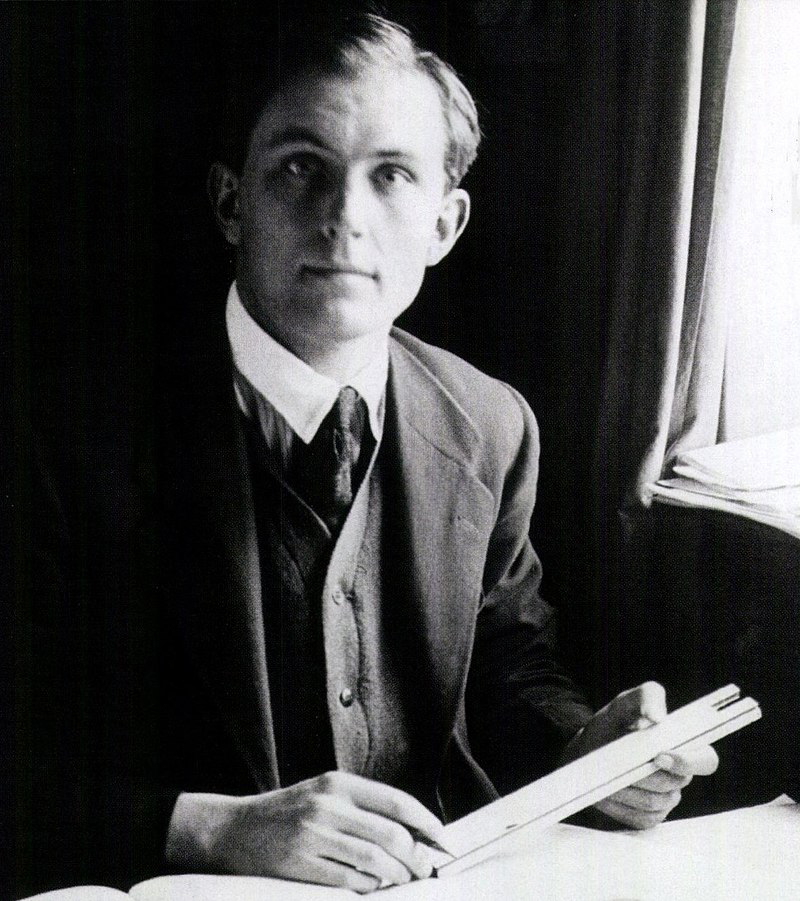
Charles Amherst Villiers, the engineer who supplied the supercharger for Bond’s first Bentley, was a friend of Ian Fleming
Highly distinctive it may have been, but “ungainly” and “less happy” have been some of the more diplomatic descriptions over the years. Comparing the Chapron creation with the first generation 1955-57 Thunderbird does reveal a square-rigged similarity of rear line unknown on any other R-Type Continental. The car still survives, albeit modified in 2005 with its rear end redone in aluminium to the style originally intended by Mulliner. The look may be more harmonious and traditional, but given the huge interest in all things 007, it seems a shame that such a unique Continental – and one that inspired a Bond car – has been altered.
It seems that Fleming viewed the Chapron Continental in London during 1960, and based the genesis of The Locomotive on its real life back-story. Further tweaks were carried out to Bond’s car in the On Her Majesty’s Secret Service novel, published in 1963. By now, the Bentley had acquired an Arnott supercharger controlled by a magnetic clutch. Unofficially fitted by a Secret Service expert, it was activated by a red dashboard switch. The fitment was frowned upon by Rolls-Royce, who warned that the crankshaft wouldn’t take the extra load and “washed their hands of their bastardised child”. Bond got to sample The Locomotive’s true potential by chasing Contessa Teresa ‘Tracy’ di Vicenzo – his future wife – on a French road. Despite it hitting 125mph, her Lancia Flaminia Zagato Spyder was able to outclass the big British bruiser in bends.
Fleming died the following year, and although some posthumous works appeared, the Bentley played no significant role. Kingsley Amis, writing as Robert Markham, penned a continuation book Colonel Sun in 1968, in which Bond still had the Continental. 1973’s The Authorised Biography of 007 by John Pearson attempted to put flesh on the bones of Fleming’s hero and mentioned a 1937 car crash with the ‘Blower’, resulting in it ending up in the River Seine and giving its owner the infamous scar down his left cheek.
This semi-retired fifty-something Bond had graduated to a borrowed and battered Rolls-Royce Corniche, although he wasn’t fond of it, commenting that “the last real car that Rolls produced was the 1953 Silver Wraith. One of those with Mulliner coachwork and you have something.” He referred to his old Bentley as his very favourite: “The essence of a car is that it should be part of you, an expression of your character.”
The only other Bond novels during the 1970s were adaptations of The Spy Who Loved Me and Moonraker movies. Thus Bond drove a submersible Lotus Esprit in the former and piloted a space shuttle in the latter.
At the start of the 1980s John Gardner embarked on a fresh continuation series but his Bond initially favoured a Saab 900 Turbo. Then, in 1984’s Role of Honour, past allegiances were revived with 007’s purchase of a Bentley Mulsanne Turbo, financed by the proceeds of a rich uncle’s will that dictated at least £100,000 being spent within four months “in a frivolous manner”. A presumably very happy Bond popped into the Berkeley Square showroom of Jack Barclay to order a Mulsanne in British Racing Green with a magnolia interior. A short time later, there was a day spent at the Crewe plant so he could specify it being built with a concealed weapons compartment and a long-range telephone. The total outlay was £70,000. Sometime later, Bond traded up to a Turbo R.
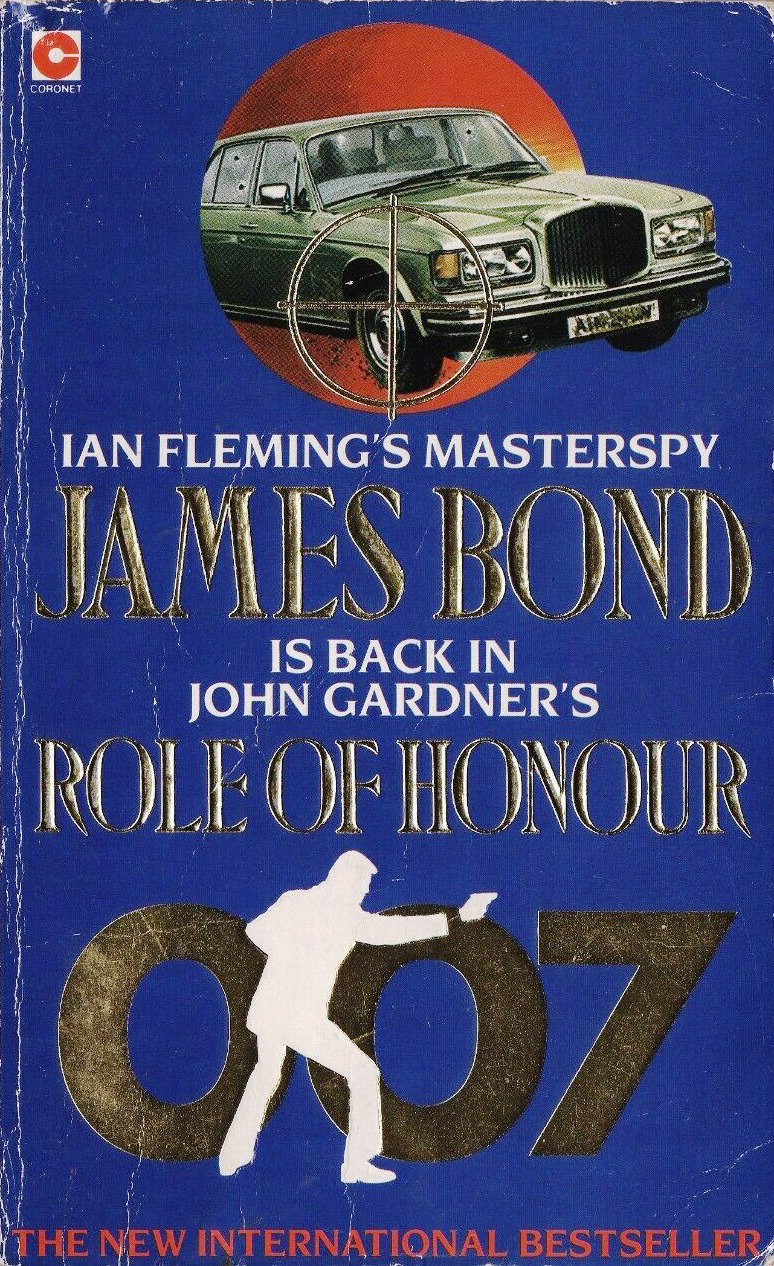
Raymond Benson’s following custodianship of the literary Bond lasted from Zero Minus Ten in 1997 to the novelisation of Die Another Day in 2002. He favoured other marques for 007, although the Turbo R was mentioned for continuity. More recently, several different authors have contributed to the Bond canon.
The centenary of Ian Fleming’s birth in 2008 was marked by Sebastian Faulks’ Devil May Care and, being set in 1967, The Locomotive returned. The eagerly awaited novel had the highest profile of any 007 book since the 1960s, but not everybody was happy that Bond was back in a Bentley. “Who would want to read the book?” commented Aston Martin’s chief executive, Ulrich Bez, perhaps with tongue planted somewhat in cheek. “The film is what made James Bond famous. In the films, Commander Bond requires the best of British. And that’s an Aston Martin.”
Bentley, however, was having none of it; Richard Charlesworth, the company’s director of royal and VIP relations, pointed out that “it’s quite nice from a historical perspective, as James Bond drove Bentleys in the books. The way he (Fleming) wrote it, James Bond almost had a love affair with his Bentleys, almost more important than his conquests of women.” Bez further suggested that Bentley was trying to muscle in on Aston’s action, to which Charlesworth retorted: “Had we made any effort, he’d have had every right to be dismissive. But we’re not. We’re not paying to be in the book.”
It seems Bentley’s main involvement with Devil May Care was a £750 Bentley Special Series leather-bound edition, incorporating a pewter model of The Locomotive. The firm trimmed the 300 books using the same materials, techniques and styles as in its interiors, and also loaned a full-sized classic Bentley to support the launch. The Aston versus Bentley spat fizzled out after Corinne Turner, managing director of Ian Fleming Publications, explained that “Ian picked the cars he liked himself at the time. And in the Bond books he wrote himself, Bond’s personal car was always a Bentley. The Aston Martin was one of the MI6 pool cars.” Peace in our time…
Bentley also got involved with the next novel, 2011’s Carte Blanche by Jeffrey Deaver. The setting returned to the current day, and 007’s personal transport was reborn as a granite grey Bentley Continental GT with black hide interior. There was a knowing tip of the hat to the earlier machine, with a mention that Bond had “bought his first Continental some years ago” – although as Deaver’s 007 was born in 1979, its specific details aren’t mentioned. Even a quite well-heeled 32-year-old might have struggled to afford an R-Type Continental by the 21st century. The book’s launch, at London’s St Pancras station, saw its author arrive in a Continental GT accompanied by stuntwoman, model and actress Chesca Miles, after which Royal Marine Commandos abseiled from the roof to hand over a copy of the novel.
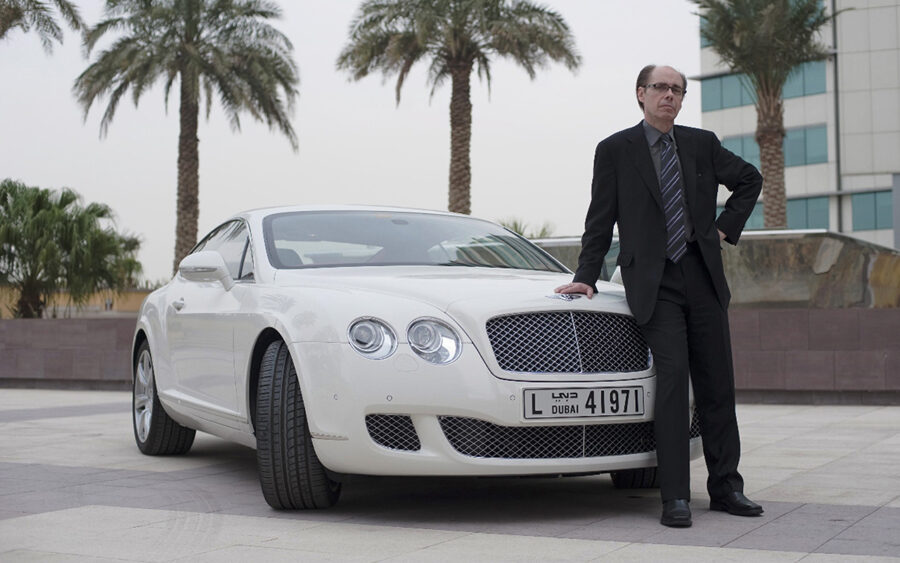
Author Jeremy Deaver put his interpretation of James Bond in a modern Continental GT, with Bentley providing a car for publicity purposes
There was also another Bentley limited edition, similar to its Devil May Care predecessor but this time running to 500 copies, presented in a polished aluminium GT-shaped case, complete with a 9mm bullet included – yours for just £1000. Aston Martin deemed it diplomatic to stay quiet this time around.
William Boyd had a stab in 2013, jumping back in time to 1969 in Solo. This placed Bond in a Jensen FF, the innovative four-wheel drive offshoot of the Interceptor. The rather weak premise was that the R-Type’s gearbox had given up the ghost and was being replaced. It’s hard to believe that a new transmission could be such a convoluted process that hardcore Bentley boy Bond would splash out a hefty (then) £7705 on a new car instead, but 007’s world has never been too rooted in reality.
The two most recent works have been by Anthony Horowitz. Trigger Mortis (2015) was set in 1957, and the natural order was restored by 007’s use of the period-correct Bentley MkVI, albeit awaiting another Amherst Villiers supercharger to be fitted and featuring Q Branch gadgets such as an alarm button, run-flat tyres and a secret weapon compartment. Forever and a Day (2018) wound the clock back even further to 1950, with a pre-Casino Royale new 007 investigating the death of his double-0 predecessor.
Unfortunately, given his close attention to detail elsewhere, Horowitz seemed a little confused and “the crumpled wreckage of a steel-grey MkII Continental Bentley” was described as being tucked away in an East London storage depot. Bond envisages sorting it out to replace the Jaguar XK120 he regrets having bought. Fleming’s 1950 Bond would still have been driving his old ‘Blower’, while the Continental was four years from being built, let alone crashed.
The rich literacy legacy of Bond’s Bentleys isn’t echoed nearly so much in the films. Nevertheless, the marque is there, if overshadowed in a way that would no doubt please Ulrich Bez. There was a brief appearance of a British Racing Green 1935 Bentley 3½ Litre drophead coupé with Park Ward bodywork alongside Sean Connery in From Russia with Love, and it was actually the first Bondmobile to be gadget-equipped thanks to its on-board telephone – quite something for 1963. However, in the following year’s Goldfinger – and during one of the series’ most iconic scenes – Bond gets told by Q that his Bentley has had its day and is introduced instead to a silver Aston Martin DB5, a car “with modifications”. The DB5’s subsequent super-stardom guaranteed there would be no going back to Bentley.

The first 1980s James Bond novels by John Gardner saw Saab grabbing every opportunity to publicise Bond’s switch of allegiance from Bentley
While the official films ignored Bentleys thereafter, two unofficial efforts did feature them. 1967’s spoof Casino Royale was a chaotic, confusing and psychedelic mess, somewhat redeemed by its superb soundtrack and David Niven as the retired Sir James Bond driving a 1923 Bentley 3 Litre Automarine-bodied two-seater, complete with fake supercharger on its nose. That it managed to keep up with a Jaguar E-Type was impressive. That both had trouble out-pacing a remote control, explosive-packed Bedford CA van was rather less so. Despite some rigorous on-screen antics, the Bentley – chassis number 155 – survives today, albeit now registered ME 5800 instead of the K 19 plate that it wears with Niven.
Connery returned to the role of 007 in 1983’s Never Say Never Again, a direct rival to that year’s official Bond offering Octopussy starring Roger Moore. A blink-and-you’ll-miss-it segment sees Big Sean’s Bond gazing fondly at his 1937 Bentley 4¼ Litre Gurney Nutting Three-Position Drophead Coupé. Again, the car – chassis number B129JY, registration DYM 800 – is still around now, albeit restored to original blue from the black that it wore alongside Connery.
Bentleys have lasted almost 70 years in the Bond books, and no doubt they’ll accompany 007 for many more years to come. And who knows? Perhaps one will re-emerge in a future cinematic adventure as well, once Daniel Craig moves on. After all, fresh Bonds have sometimes introduced fresh marques – Roger Moore and his Esprits, the BMWs of Pierce Brosnan – and a modern Bentley is more than a match for a contemporary Aston Martin these days. James Bond will return… and some day he might even do so in a Bentley.

